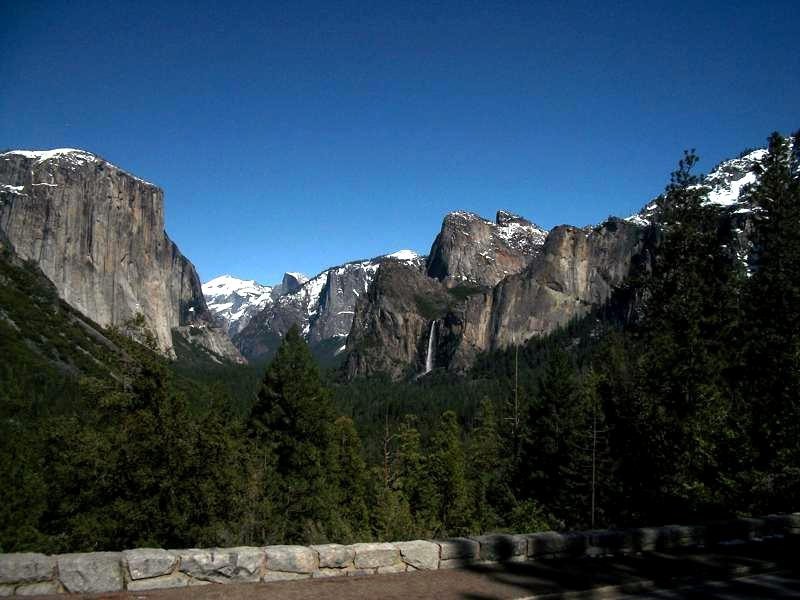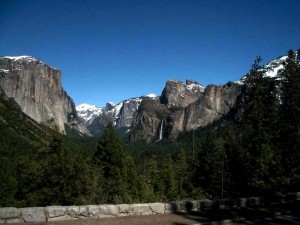
Ominous cloud cover heavy-laden with moisture hung above the 761,266 acre Sierra Nevada National Park and dumped two feet of snow for our first night tent camping in Yosemite. Yes, tent camping. To some this may not sound brave or rugged, but to this native Southern Californian, it was. My husband Luke and I arrived on Easter Sunday to sunny skies, grassy meadows and some snow way up on the domes and cliffs.
Our campsite was perfectly dry, packed dirt. We knew it was going to snow, so with the EZ-Up over the tent we waited for the inevitable. We were all bundled in sweats, long underwear, three shirts, one hoody, my winter fur-lined coat, and thick gloves.
As the day grew dark and with Pedro, my shivering, short-haired Chihuahua in tow, I crawled into my 0 degree mummy bag. It was super cold. I opened ten hand warmers throughout the night, sticking them in my socks, gloves, and undies to warm my bottom.
Before my husband came to bed, he hung out by the fire with our neighboring campers, who were the only other tent campers in the usually tent-infested campground. There were plenty of motor homes with generators running until 10 p.m. (turn off time), but no other tents. Our neighbors were an atypical father-and-son team from Santa Rosa. The father was a neo-hippy who wore a huge, gorgeously polished stone around his neck – but you would wear one too if you had his astrological nightmare.
“My house is always in the Sun of Scorpio,” he said. “It is a real nightmare. But like a blind man who gains hyper perceptions in touch and smell to accommodate his handicap, I have gained strengths where my astrological weaknesses are greatest.” Right buddy!
Aside from the superstition, the guy was massively intellectual to the point of paralysis. The moon-child dad micro-instructed every

move his teenage son made. Setting up their borrowed tent was a thousand-step verbal breakdown of every single movement. Putting the poles together required a lengthy lecture into the physics of pole and rope mechanics.
Once all the poles were set up and the tent ready to clip to the poles in one of the simplest tent designs I have seen, poor dad almost fell to pieces with overthinking the next 15 steps required. He could not visualize the requisite set-up and was telling his son to take it all down and that it would never work. There were only five minutes of work left to finish setting up the tent, but the dad was having an intellectual meltdown. So the son came up with a contraption to make up for the lack of one little piece at the top to hold it together. It was a simple, thin knotted rope that he called “elegant.”
The word alone encouraged the dad to continue. In the end it was set up gorgeously, and they were able to move on to cooking dinner, which was more of the same micro-managing – only worse because it was snowing and the beans were turning to mush and getting watered down from the snow falling into the pan.
 Finally Luke came to bed after knocking six inches of snow off the EZ-Up that stood over our tent. Breathing fat columns of foggy breath, Luke and I kissed each other good night and dreamt of bliss. We woke up in the night and each knocked another six inches off of the EZ-Up about every two hours. And still again in the morning we got up and knocked off another foot of cement-like snow.
Finally Luke came to bed after knocking six inches of snow off the EZ-Up that stood over our tent. Breathing fat columns of foggy breath, Luke and I kissed each other good night and dreamt of bliss. We woke up in the night and each knocked another six inches off of the EZ-Up about every two hours. And still again in the morning we got up and knocked off another foot of cement-like snow.
Surely the EZ-Up and tent would have collapsed had we not been vigilant, because in the morning, our father and son neighbors’ beautiful, big tent had collapsed to the size of a very large turtle. They were in good spirits though, and like the night before when huge snow clumps were falling on them and their fingers were so cold they couldn’t move them, they both kept reiterating, “But this is great!” When they crawled out of the knee-high tent through the little remaining hole, they both said, “But this is great!”
All the next day people were hauling their collapsed EZ-Ups and awnings to the trash can. There were eight awnings and EZ-Ups at the two nearby trash containers alone. The snow all night was silent, and when we would peek out, it was the most magical scenery. The white flakes descended like thousands of white fairies floating to the ground. It made me understand some of the sappy personifications often given to nature. Shoot, I just called the snow “thousands of white fairies in a magical wonderland.”
But the one thousand-soldier fairy army gathered in troops of millions and settled in the tree canopies above our tent and
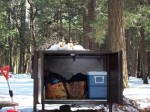
throughout the campground, forming rock-heavy, white slabs which, when massed and outweighing the tree branches, would fall like bombs on our EZ-Up, car, neighboring motor homes and the ground. It sounded like a battlefield at times and at 3 a.m. required a Tylenol PM to settle the nerves. In the morning two feet of snow covered absolutely every single thing. Still snowing, it was divinity. How many times must I thank Frank Lloyd Wright for saying, “I believe in God and I spell it N-A-T-U-R-E.”
When I saw the Yosemite Royal Arches (the gorgeous, two thousand-foot-high rock face behind the rugged Awahnee Inn) covered in snow, I did not see God’s creation; I saw God. And I went on to find God repeatedly to the point of ridiculousness; in the face of Half Dome, in the luscious meadows, in the eyes of the tagged bear, among the herd of nine deer and at the marsh.
Camping in the snow was hard work, and surviving was a one-to-one ratio. For every movement there was a distinct survival purpose, and it was an all-day-and-night affair. There was shoveling the snow off the sides of the tent and creating a perimeter in case of melting, and shoveling the area we wanted to call our living/cooking space. There was walking to and from the bathroom, which was an adventure in sinking and snow plowing. There was cooking in the snow while huge ice chunks dumped on you, and most importantly, there was getting and keeping shoes dry. This was more important than eating because icy cold feet feel like death. But the activity was profoundly satisfying and necessary, making life make sense.
We hiked at least eight miles per day in the snow, which turned to slush, then mud in some places, by the end of the week. But our campsite, beneath 100-year-old Ponderosa Pines and fir trees, stayed thick with snow until we left.
Mist Trail and Vernal Falls Hike
 The hike on the Mist Trail to Vernal Falls was gorgeous, strenuous, uplifting and annoying. There were huge, moss-covered boulders that dripped with delicate, melting snow. The effect was a sparkling, drippy delight. We stopped to take pictures of a grotto of dripping deliciousness, but there was a boy throwing snowballs at the very icicles we wanted to take a picture of. His mother was enraptured with his athletic acumen and encouraged him by cheering. Stupid boy. Stupid mom.
The hike on the Mist Trail to Vernal Falls was gorgeous, strenuous, uplifting and annoying. There were huge, moss-covered boulders that dripped with delicate, melting snow. The effect was a sparkling, drippy delight. We stopped to take pictures of a grotto of dripping deliciousness, but there was a boy throwing snowballs at the very icicles we wanted to take a picture of. His mother was enraptured with his athletic acumen and encouraged him by cheering. Stupid boy. Stupid mom.
The hike was so slippery. My hubby Luke had our Chihuahua Pedro in the backpack; Luke was in pain because of a pulled back muscle, and fell once with Pedro jumping out to save himself. Pedro was lazy and loved the backpack, so we stuck the hot hand warmers in next to him. He thought he was in heaven.
Wikipedia describes the Mist Trail perfectly: “Along the trail, the Merced River is a tumultuous mountain stream….. Enormous boulders, the size of a house, are dwarfed by the sheer faces of exfoliating granite, which rise 3,000 feet (914 m) from the river.”
We passed the amazing Illilouette Falls along the way. The view was good, but the trail was skinny, and the crowds (which number 3.5 million people per year) were so annoying. Even though the people were cool Europeans, hippies and nature people that I’d normally love, en masse they may have well been rats. The last bit of the trail is very steep rocks, but Vernal Falls is absolutely magnificent and the incredible amount of water at this time of year makes it worth dealing with the crowds and steepness. Ten hikers in as many years have died while diving or swimming here, so I am fortunate to be a coward and will never have to face such a death.
We hiked/slid back down in the slush, and at bottom we discovered Happy Isles Fen, which is a two-acre wetland or marsh, and is
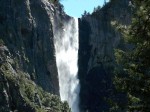
quite rare in the Sierra Nevadas. Happy Isles was thankfully empty of people. We were pretty much blissfully alone. And apparently the Fen didn’t catch much attention, because when we hiked that lovely area, there were no people at all: none on the Fen. The Fen is a gorgeous marsh surrounded by trees and it was my favorite place. Go There. It embodies e.e. Cummings musing, “The world is mud-luscious and puddle-wonderful.” A boardwalk takes you right through the center of the marshes where even in the snow, birds and frogs abounded.
The following day we hiked to Mirror Lake and beyond. The trail is paved and follows the gorgeous Merced River. It is a nice, easy hike and was not too crowded because we were there early. Mirror Lake is really a pond, and it mirrors Half Dome. The pictures we took can be turned upside down and the mirror image of Half Dome is so perfect in the lake that you are hard-pressed to tell which end is up. The pond is not grand, but it is beautiful.
There were many professional and unprofessional photographers, painters and sketchers sitting around creating their art: copying and re-creating the perfection of the lake. And there were tourists: whiny kids and people with the wrong shoes and clothes amassed at the lake; people from all over the giant world sat and took up fat space. But we hiked past the lake, past the hordes, and up a trail that follows the river, and we were utterly alone. We may have passed a few people on the way down, but otherwise we were thankfully alone.

On the trail, we found a giant waterfall that started thousands of feet up on a rock face. It was mostly hidden by the forest that surrounded it, and it trickled down to a gorgeous creek that crossed our path. Someone must have poured bleach in it, because it was so clear and clean. I heard tens of birds, but saw none, and Pedro sat contently in the backpack.
We finally arrived at a bridge and took 10 take-it-yourself portraits with the river in the background. However, our fat heads were so large in the picture that the river was blocked out except a few very large boulders that vied with our heads.
The river spun down fast over huge boulders and an American Dipper (cinclus Mexicanus) flitted and caught small aquatic creatures. There were more of the moss boulders with trickling water on our hike down. We hiked in silence, but our boots and the river and the trickling water kept a rhythm that moved us. There was a lot of slush and slippery snow, but the trek wasn’t steep, so we didn’t fall or slip much. We had boot-dry duty that night, and our waterproof hiking boots were soaked through, but they dried well when placed before the camp heater or campfire. We ate home-cooked beef stew, and bread and butter with wine, for dinner. I love eating at camp. We were so hungry from our hike that the food tasted marvelous, plus cooking and eating outdoors is celestial.
We got up the last morning and went to the cafeteria for breakfast. The cafeteria in Curry Village was a wonderful treat, and I ate a
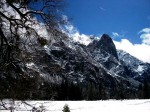
huge plate of eggs and potatoes, then eight pieces of French toast – lightly powdered with sugar, no syrup, just butter. Yes, I said eight pieces of French toast! We hiked a flat, dry trail at the foot of El Capitan. It was a sweet, easy, un-peopled trail that lacked the wow and pizzazz of Vernal or Yosemite Falls, but I loved it all the same. I was stiff and sore from hiking and sleeping in the mummy bag, trying not to move so I wouldn’t lose my precious trapped heat. So the mellow trail suited me just fine. There were bugs and flowers, unlike our campground, which was socked in with snow and thick in trees. A delightful creek crossed our path, and it was as clean and gorgeous as anything I have ever seen. Then we came to the Merced River and sat on a huge boulder over looking huge rapids, spying two mergansers fluffing their feathers on a rock.
We drove the loop and saw a bear, our second one of the week. It was huge and brown, with a cream-colored chest and chin, and a red-tagged left ear. Most bears are tagged in Yosemite. The bear elicited wonder from all. When I see bears, I get all choked up and teary. Crowds of people formed to stare, photograph and whisper in awe. All the people were moved; our ugly faces were uplifted. There was a silent communion and celebration amongst the people.
The exchanged glances and quiet comments gave a glimpse into the profundity of what E.O. Wilson calls “biophilia”: the necessity of humans to bond with other species and nature. We were all in love for just that moment with something immediately necessary and fragile. It was as if we all thought the same thing at once: Stay with me. I did not want to leave, ever.
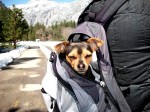
Rugged, yet tender, the American black bear (Ursus americanus), one of 300 to 500 estimated to live in Yosemite, lay on his tummy, sniffed around, slept, got up, and ate grubs, grass and acorns in the meadow. He dug with his nose and claws in the grass, and looked over at the people occasionally when someone sneezed or coughed. There have been zero human fatalities by bears in Yosemite ever!
Seeing the calm bear saunter about and be totally at ease with people (who kept their distance) was a wonderful counterbalance to the screaming fear of urban mythology. However, once bears get the taste of sugar, marshmallows and candy from negligent campers, they turn into sugar crack heads and will sell their mothers to get more. They will rip the doors off your car, and sneak into your campsite and take food from your table while you sit there with your mouth open. (I’ve had this happen.)
Yosemite takes its bears seriously and wants them to remain a wild feature of the park. There is a $5,000 fine for leaving food in your car. There is a saying that goes: A fed bear is a dead bear. There are bear lockers at every campsite so there is no reason for error. Five bears last year became aggressive and were killed by park officials. But the most important thing to remember is that bear attacks are rare.
Yosemite smashes into your soul and forces one to remember nature and the human requisite to be in it. Without sounding too neo-hippy, communion with things such as wildlife, undeveloped nature and electronics-free outdoors is gut-level imperative to one’s soul. Being in Yosemite packed me with a proper contentment and made me feel rugged and tender all at once.
Any glimpse into the life of an animal quickens our own and makes it so much the larger and better in every way. ~John Muir
By Suzie Hemphill
Photography: Suzie and Luke Hemphill
Copy Editor: Katherine Sweet

